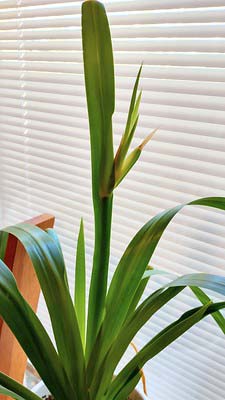Walking Iris

Neomarica spp. is one of those plants with a number of common names. Some gardeners call it fan iris because its leaves overlap, forming a fan of greenery. Or maybe you know it as apostle plant. This name was given to it because some believe it will not bloom until it produces twelve leaves. The delicate flowers of this plant inspire yet another common name: poor man’s orchid.
Neomarica species get their most common name—walking iris—from their propagation habit. New plantlets form at the tops of flower stalks. As they grow, the stalks bend to the ground and the plantlet takes root. Eventually, the new plant will repeat the same process. In this way many walking iris plants “walk” through the landscape. However, not all species of Neomarica walk. Some species stems don’t bend as readily as others and the plantlet is held airborne.
Whatever you call this plant, it makes a curious addition to any shade garden.
Characteristics
Walking iris is not native to Florida but it is considered a Florida-Friendly plant. It is commonly found in USDA Hardiness Zones 8B–11.
Neomarica spp. are clumping herbaceous perennials. They produce long, glossy green leaves and small, iris-like flowers. The flower’s outer petals spread almost horizontally. Three curled inner petals add a pop of texture to the center of the bloom. These striking blooms only last a day, but as flowers die more will follow for an extended period. How long your plant continues to flower will depend on the species.
Neromerica flower color differs between species, too. N. longifolia has yellow flowers with mahogany patches. N. gracilis and N. northiana have white blossoms with blue and brown markings. N. caerulea has blue-purple petals and tall, upright foliage.
There is another plant often referred to as walking iris: Trimezia martinicensis. This plant produces yellow flowers similar in structure to those of Neomarica. Both species are commonly be found in Florida gardens, too. Be aware that when someone is talking about “walking iris” they could mean Neomarica spp. or Trimezia.
Planting and Care
Walking iris can be grown in full or partial shade. It can tolerate a range of soil types but does best in moist locations. Walking iris has a moderate growth rate and does well in mass plantings, too. Clumps of upright foliage provide year-round interest, striking even when not in flower. It is also well suited to containers and hanging baskets where its arching stems can be highlighted.
Walking iris is evergreen in zones 10–11. In the northern parts of the state, it often freezes to the ground, but will return from the roots in the spring once the weather warms up. You can use woven fabric covers to protect your plants should freezing temperatures be in the forecast.
If your landscape is too far north or too dry, walking iris may not thrive outdoors. Happily, it also makes an excellent houseplant. Keep your plant in a bright window, but out of direct sunlight, and water frequently, or the tips of the leaves will brown and droop. As plantlets form, you can expand your collection or share them with friends.

Neomarica spp. is sometimes available in nurseries and is a popular pass-along plant. For more information on walking iris, contact your county Extension office.
